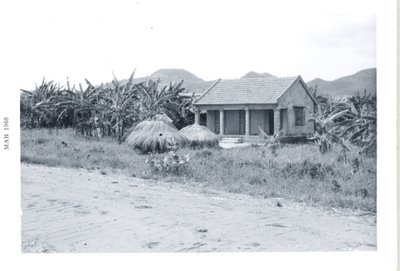Southeast Asia

The top picture is the jeep in front of me as we moved along a dirt road between rice paddies. Rice was the big crop grown in the areas where we operated in Vietnam. After the rice crops were harvested, the paddies became dry and hard and we could walk across them without sinking. There were narrow raised areas around every few acres to contain the water and for walking by farmers and their cattle. Water buffalo were used in cultivating the rice paddies.
The picture below shows a blown bridge and the bypass around the destroyed overpass. I remember this stretch of road north of Tuy Hoa. The bridge was most likely destroyed with explosives set by Viet Cong guerrillas. Viet Cong or VC were usually South Vietnamese who fought without uniforms for the north. They were small bands of fighters who would blend with the civilian population. The VC employed ambush, hit and run, and sniper tactics when confronting U. S and ARVN forces. ARVN was Army Republic of Vietnam, the legitimate army of South Vietnam.
Viet Cong frequently buried mines in roads during the night. They were usually pressure sensitive type mines that exploded when a vehicle rolled over them. These mines caused many deaths and injuries to civilians as well as U. S. Military personnel. Sweeping the road with metal detectors was a daily task by military personnel.
The last picture is a non-typical masonry or stone building beside a road.
How did the United States get involved in Vietnam? If you're my age (around 60), you've heard this question debated. If you're younger than 40 you may or may not know the answers.
As a nineteen year old person at the time of the mid-1960's, my understanding was that we (the U.S.) had been asked by the government of South Vietnam to help them secure their country from aggression by North Vietnam. North Vietnam was a communist government and the United States was concerned about the spread of communism in southeast Asia. This spreading was referred to as the domino effect of one country after another falling to communism. Cuba, closer to home, had recently come under dictatorial or communist control.
When I arrived in Vietnam, there were around 60,000 US troops there. When I departed a year later, I recall that there were twice that many. During the peak of that 12-year war, there were over 500, 000 in country at maximum build-up.
The United States involvement in the war began around 1963 and ended in 1975. I was there early as the war scaled up in 1965. My tour of duty lasted the full year of 1966.
I belonged to a combat unit in the 1st Brigade of the 101st Airborne Division. Some officers in this brigade became highly decorated for combat actions and, deservingly, gained national attention. David H. Hackworth (Captain or Major at the time) became the most well known with his book titled About Face. He made many television appearances to talk about military affairs during the years after the war.
Return here on Saturday, August 26 for an update.
Have a good day!


Labels: Vietnam


0 Comments:
Post a Comment
<< Home